BookStore Docker 3 : Dockerlize Spring Application & Connect to MySQL Container Only With Dockerfile
 Byung Joo Jeong
Byung Joo JeongTable of contents
- Docker Reference Link
- 3 Key Terms for Docker
- Prerequisite
- Dockerlize Spring Boot Application
- Step 3: Dockerize the Spring Boot Application
- Step 4:Verify 'Jar' file has been created
- Step 5. Build Docker Image
- Step 6. Verify Docker Image
- Step 7. Run & Create the Spring Container
- Step 8. Check the status of Running Containers
- Step 9. Link both containers to each other
- Step 10. Verify You can access 8080 Port
- Trouble Shooting
- I can't see the spring-bookstore-container on Docker Desktop
This document goal is to Dockerize Spring Application & Connect to MySQl Container.
Docker Reference Link
Docker Basic
MySQL Monitoring With Docker
Reference Link : https://joo.hashnode.dev/book-store-docker-2-mysql-monitoring
3 Key Terms for Docker
1.Docker Container - Role of Virtual Machine
Docker container is like a Virtual Machine.
It is an executable package that includes everything needed to run software.
everything that needs to run software include includes code, runtime, system tools, libraries, and setting.
2.Docker Image - Blueprint for Creating Container
A Docker image is a read-only template.
It's acting as a blueprint for creating a Docker container.
It includes application code, libraries, dependencies, and other necessary files.
3.Dockerfile - Recipe for Creating Docker Image
A Dockerfile is a text file.
It contains commands and instructions to build Docker image.
It specifies the image to use, application files to copy, dependencies to install, and commands to run.
Prerequisite
Step 1.Create Docker Container for MySQL
Pull the MySQL Image
Run(create) a MySQL Container
Verify MySQL Container
Step 2.Create Spring Boot Project and Link It To GitHub Repository
I used application.yml and .env file configuration.
Link : https://joo.hashnode.dev/bookstore-spring-env-file-setup-env-configuration-with-applicationyml
Dockerlize Spring Boot Application
Step 3: Dockerize the Spring Boot Application
1. Create a Dockerfile in Spring Boot Root Directory.
Create a file named Dockerfile with the following content:
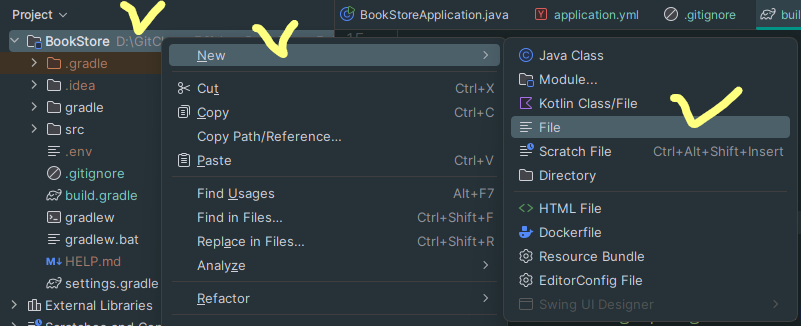
Root Directory -> Create Dockerfile -> add below content.
Dockerfile configuration
# Use the official OpenJDK image as a parent image (Base Image)
FROM openjdk:17-jdk-alpine
#Base Image: openjdk:17-jdk-alpine provides a lightweight environment with JDK 17.
# Set the working directory in the container
WORKDIR /app
# Working Directory: /app is set as the working directory inside the container.
# Copy the JAR file into the container
COPY build/libs/BookStore-0.0.1-SNAPSHOT.jar app.jar
# Copy JAR: Copies the built JAR file from the build/libs directory into the container.
# 'app.jar' in the Dockerfile is a way of renaming the JAR file inside the Docker image to a consistent name.
# Expose the port that the application runs on
EXPOSE 8080
# Expose Port: Exposes port 8080, which is the default port for Spring Boot applications.
# Define the command to run the application
ENTRYPOINT ["java", "-jar", "app.jar"]
# Run Command: Uses java -jar to run the JAR file.
----------------------------------------------------------------
#----- You can replace COPY & ENTRYPOINT with below
#COPY build/libs/BookStore-0.0.1-SNAPSHOT.jar app.jar
#ENTRYPOINT ["java", "-jar", "BookStore-0.0.1-SNAPSHOT.jar"]
Before building docker image,
gradle : clean & build
./gradlew clean
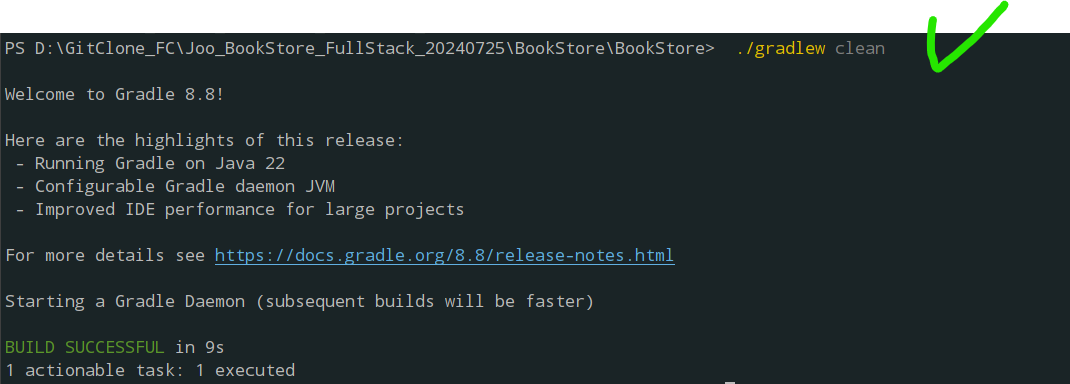
./gradlew build

or
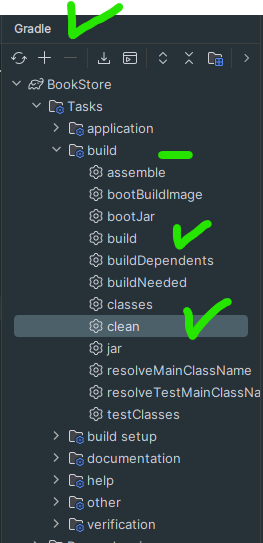
Step 4:Verify 'Jar' file has been created
- Check file directory
After running these commands, verify that the JAR file has been created in the build/libs directory. The JAR file should have a name similar to
bookstore-0.0.1-SNAPSHOT.jar.
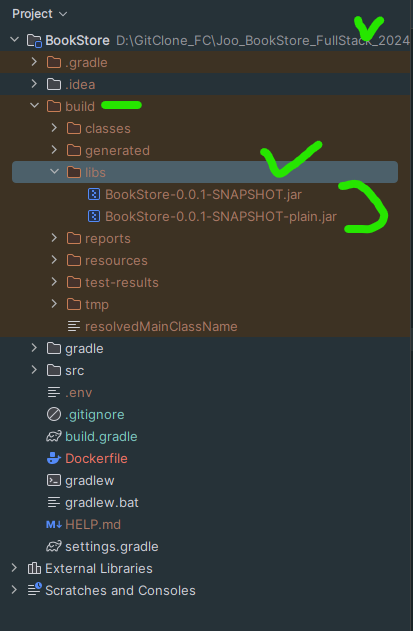
BookStore-0.0.1-SNAPSHOT.jar
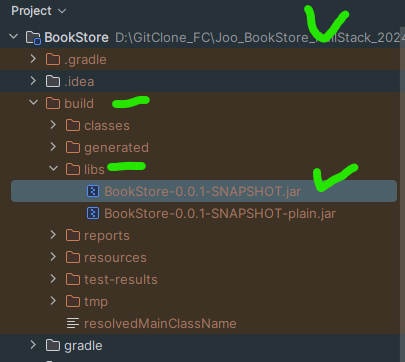
or use the command
ls build/libs/

Step 5. Build Docker Image
docker build -t spring-bookstore .
Command Breakdown
docker build
- build a docker image from a Dockerfile
-t spring-bookstore
-tflag tag : is used to specify a tag for the image, which should be lowercasespring-bookstore: the name of image you are creating, tag is lowercase, this also should be lowercase. (we can usespring-bk, which means you can set the name.)
Build Success!
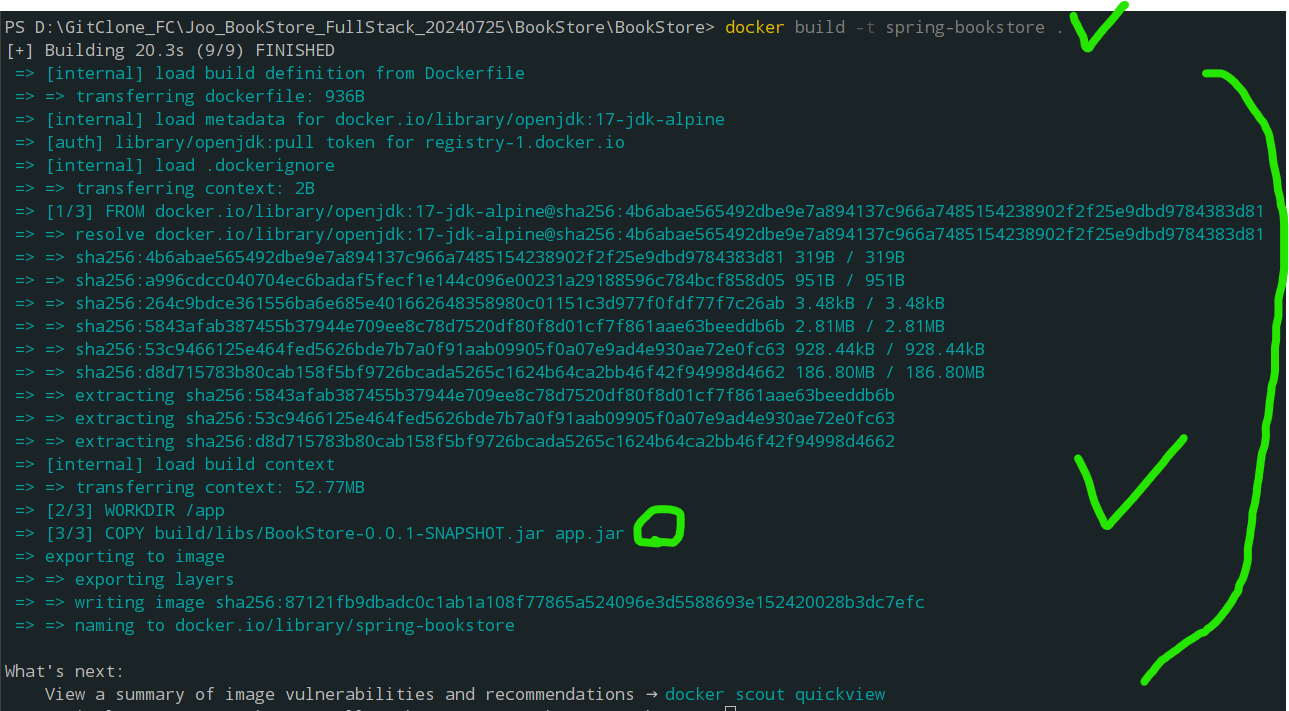
Step 6. Verify Docker Image
Verify that the image has been created successfully by listing all Docker images:
docker images

I have 2 Docker Images including mysql image
we can see
spring-bookstoredocker Image on REPOSITORY (I created atm)
Step 7. Run & Create the Spring Container
Run a container from the image you just built. This will start your Spring Boot Application inside a Docker container.
docker run -d -p 8080:8080 --name spring-bookstore-container spring-bookstore

Command Breakdown
-d
Run the container in detached mode.
Detached mode allows the container to run in the background.
Docker Container starts and runs independently of your teminal session.
You don't need to keep the terminal open to keep the container running.
-p 8080:8080
This allows you to access the application running inside the container on the port 8080 of your host machine.
The first '8080' refers to the port on your host machine.
The second '8080' refers to the port on the Docker container.
--name spring-bookstore-container: Assign a new name to the running container, in other words, it's naming your running container.
spring-bookstore: The name of the Docker image you just built.
+Host Machine & Local Machine & Docker Container?
Host Machine
Physical or Virtual Machine , where the Docker service (daemon) is runing.
In my case, It's Docker Desktop (window)
->It's machine to manage and run Docker Container.
Local Machine
- Generally it refers to your computer you are currently using.
Docker Container :
If you are running Docker Container on your personal laptop or destop
Your computer is the host machine.
Host Machine is where Docker is installed and running.
Local Machine is the machine you are currently working on.
In conclusion,
- In many cases, especially during development,
your local machine==host machine
+Detatched Mode in Docker
Simply put, running a container in detatched mode lets you use your terminal and Docker commands freely while your container continues to run in the backgroud.
Background Process: The container runs as a background process.
Terminal Free: You get back your terminal prompt immediately after running the command.
Monitoring: You can still monitor and manage the container using Docker commands like
docker ps,docker logs,docker stop, etc.
While you run the docker container, you can still use the following commands
docker ps
After docker runs, I used docker ps

docker logs spring-bookstore-container

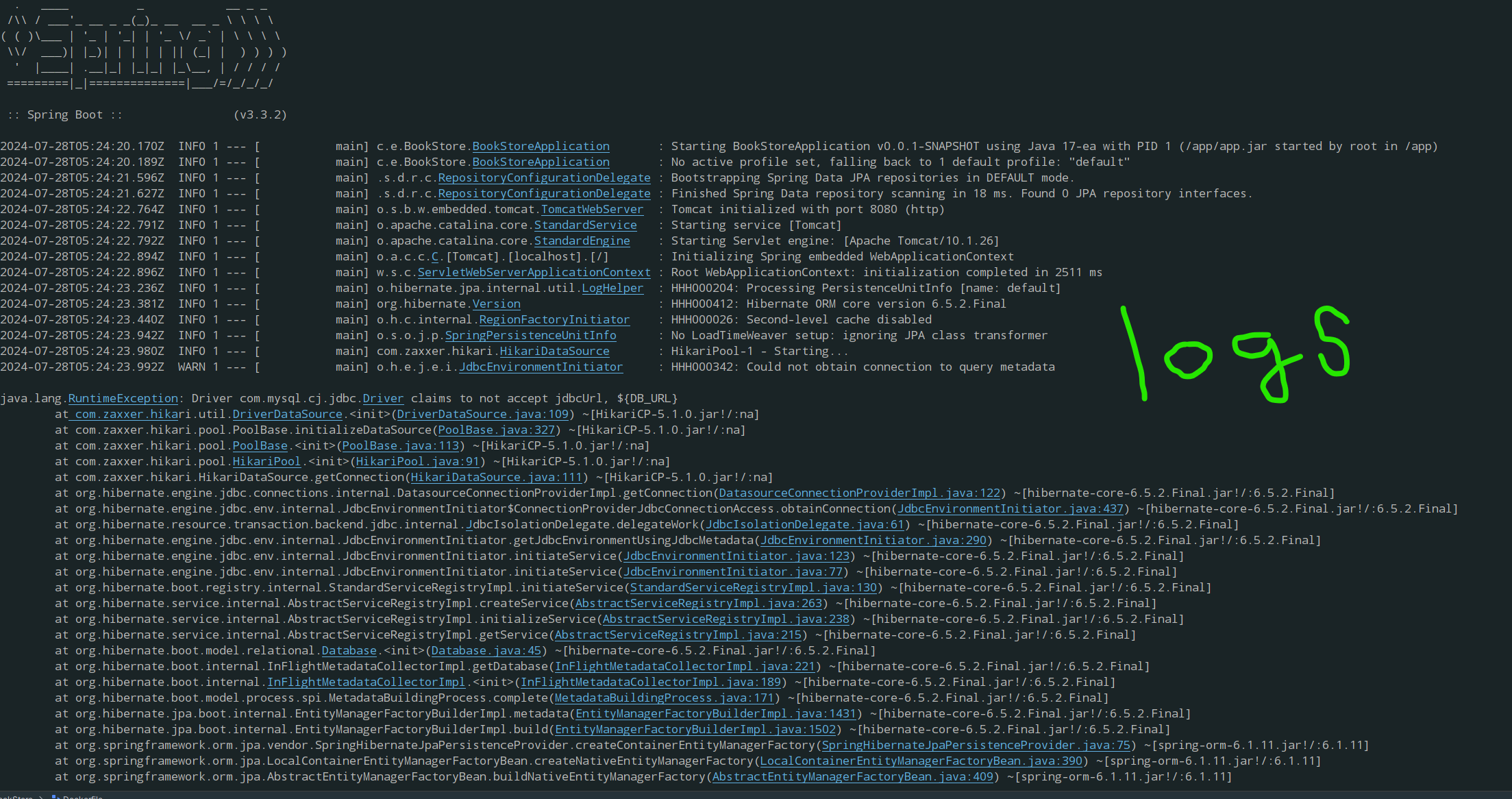
Step 8. Check the status of Running Containers
Before we begin,
check the status ofDocker Images & Docker Containers
docker images


docker ps to check running containers.
docker ps

Run mysql container & spring-bookstore-container
Start spring-bookstore-container
docker start spring-bookstore-container
Start mysql-container
docker start mysql-container

To see all status for Docker : images, Container name, ports, including stopped.
docker ps -a

: using docker ps -a we can see all containers, Images
Step 9. Link both containers to each other
1.Create A New Docker Bridge Network
Create a user-defined bridge network to allow the containers to communicate.
docker network create bookstore-bridgenetwork
2.Check All Docker Networks:
docker network ls

2.Connect both containers to new network
: Ensure your both containers are running
Connect the MySQL Container to New Bridge Network you defined:
docker network connect bookstore-bridgenetwork mysql-container
Connect the Spring Boot Container to New Bridge Network you defined:
docker network connect bookstore-network spring-bookstore-container

3. Inspect a Bridge Network to check the connection
: To get detailed information about a specific network, including its configuration and connected containers, use the docker network inspect command followed by the network name or ID.
docker network inspect bookstore-bridgenetwork
This command will output detailed JSON information about the specified network, including its name, subnet, gateway, and a list of connected containers.
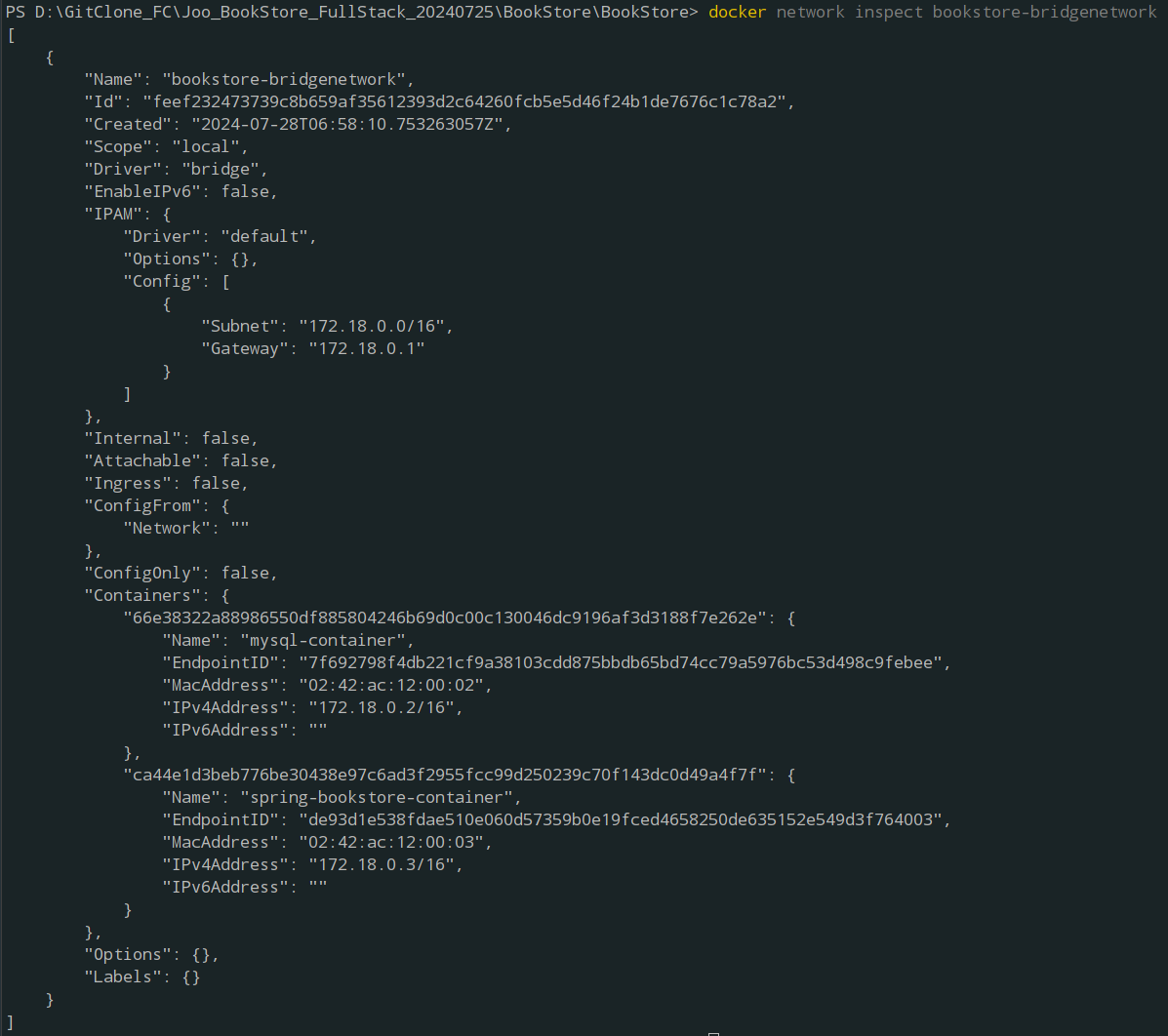
You can see "Containers" data that include mysql-container & spring-bookstore-container.
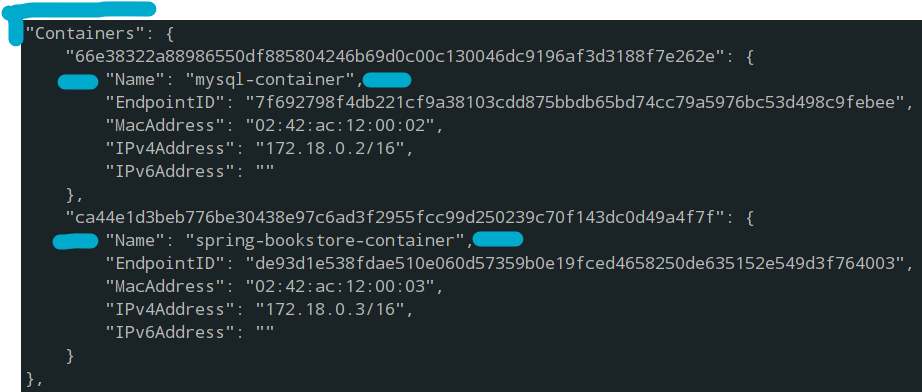
From the 'docker network inspect' output
4. Check Network Connectivity :
Verify that your containers can communicate with each other. You can use docker exec to access a container and ping the other container by name.
docker exec -it spring-bookstore-container ping mysql-container


(you can use ctrl + c to stop)
The ping statistics
luaCopy code--- mysql-container ping statistics ---
11 packets transmitted, 11 packets received, 0% packet loss
round-trip min/avg/max = 0.072/0.114/0.171 ms
All packagets were successfully received (0% package loss)
- This means that the connectivity between my container (spring) and MySQL container is stable
Round-trip times
with minimum of 0.072ms , an average of 0.114ms, a maximum of 0.171ms
This means Round-trip times is very low, times are excellent, which indicate "very quick Response" from MySQL Container.
Step 10. Verify You can access 8080 Port
docker ps -a
docker ps

1.Check Docker Container
docker pscommand can show you currently running container, whiledocker ps -ashows all containers, including those that are stopped.
2.Port Mapping
Since 'spring-bookstore-container' is mapped to '
0.0.0.0:8080->8080/tcp', you can access 'localhost:8080' on your host machine (your computer)Simply put, spring-bookstore-container is running on 8080 port, which means you can access
localhost:8080port.

I added Spring Security dependency, so I can see Login form, which confirms that Spring Boot Application is running correctly.
3.When the container is stopped (+ embedded Tomcat & Spring Container)

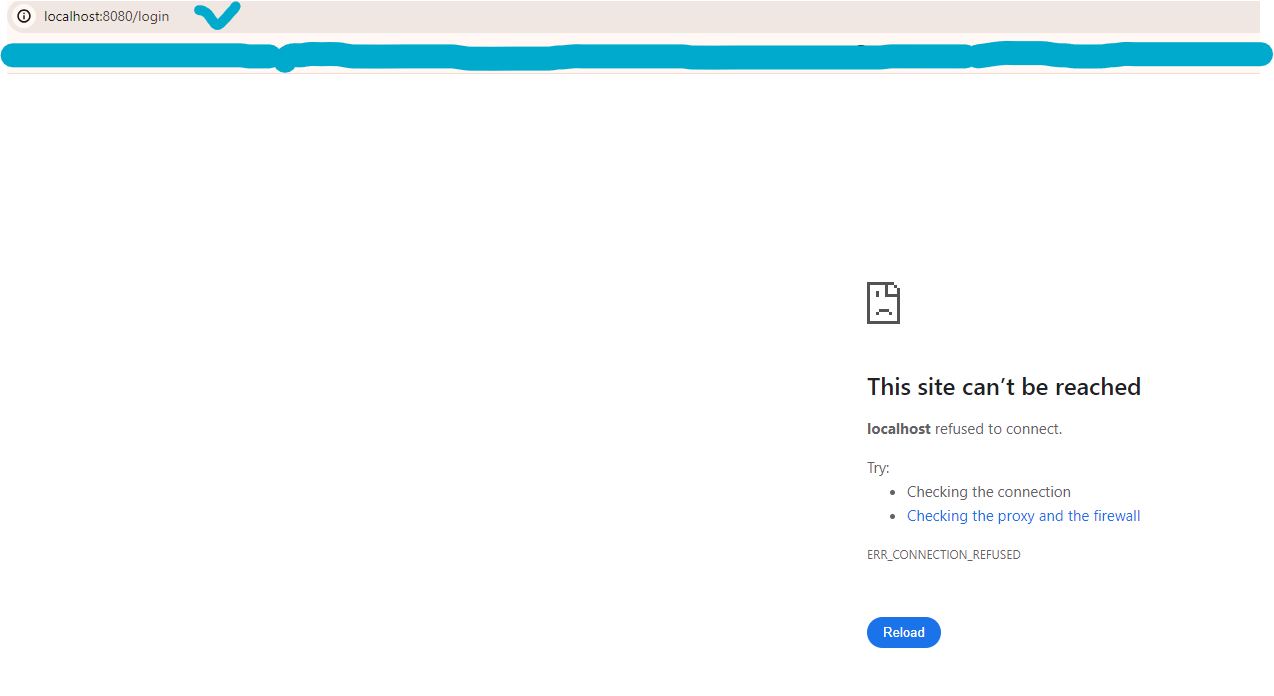
Spring Boot container runs the Spring Boot application, which includes an embedded Tomcat server. The Tomcat handles incoming web request on port 8080 within the container (Process I've done is for this.)
Spring Boot Container: This container runs your Spring Boot application.
Embedded Tomcat Server: By default, Spring Boot applications use an embedded Tomcat server to handle web requests.
Default Port 8080: The Spring Boot application listens on port 8080 within the container.
Key details of
docker network inspect bookstore-bridgenetwork:
it's clear that the
bookstore-networkhas two containers connected:mysql-containerwith IP address172.18.0.2spring-bookstore-containerwith IP address172.18.0.3
Simply put, Bridge Network Is
- In Docker, a Bridge Container is a user-defined network that allows different containers to communicate with each other.
When containers are connected to the same bridge network, To summarize
Bridge Network: A virtual network that enables communication between containers on the same Docker host.
Use Case: Ideal for scenarios where containers need to interact with each other directly but are isolated from containers outside of the network.
Trouble Shooting
Error whlie building Docker Image
The command docker build -t spring-book-store . is used to build a Docker image from a Dockerfile located in the current directory.
1.ERROR : Build Docker Image Without Docker Desktop


\==> I didn't run the Docker Desktop => Resolve : Run Docker Desktop
2.Dockerfile Wrong Configuration
:Issue With pulling the openjdk:17-jre-slim image.
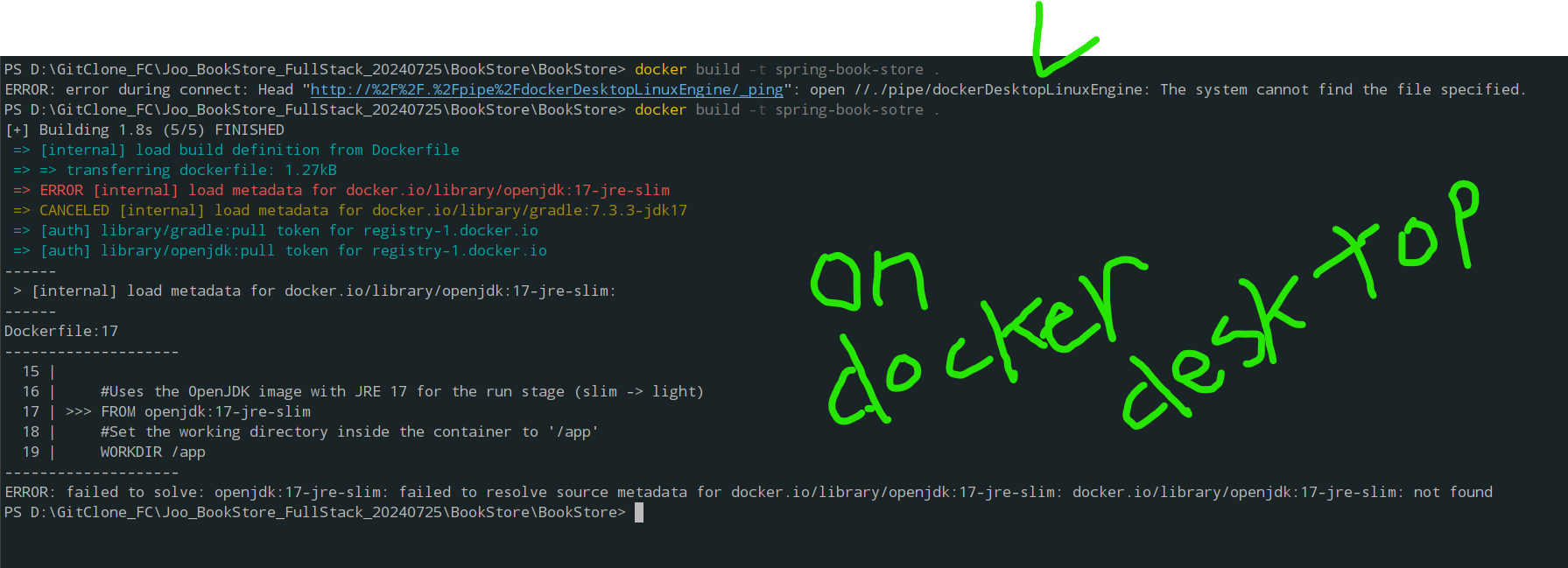

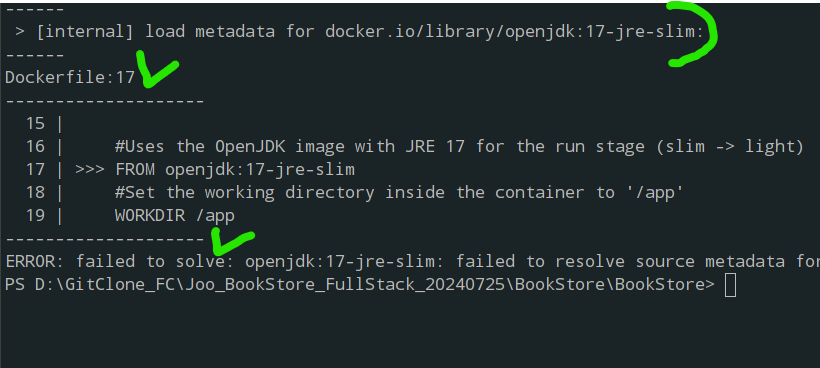
docker search openjdk
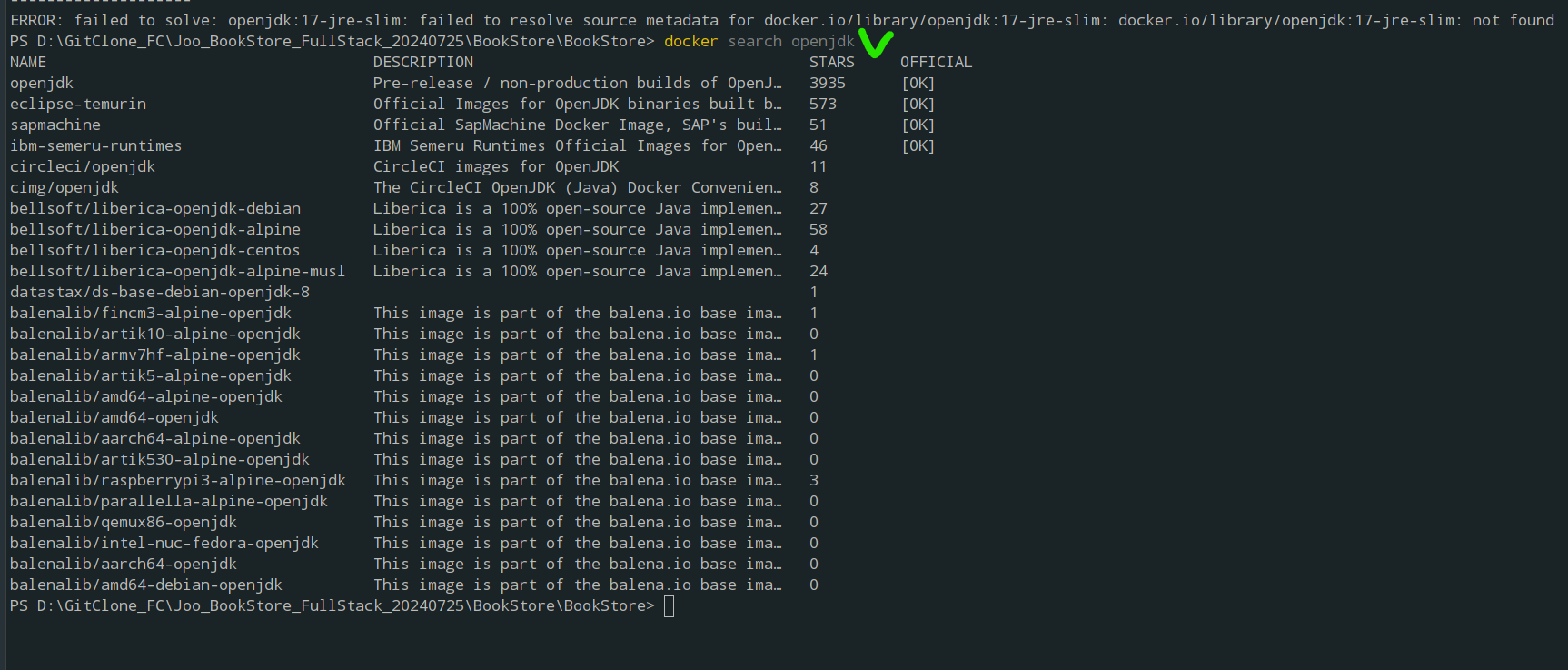
PS D:\GitClone_FC\Joo_BookStore_FullStack_20240725\BookStore\BookStore> docker search openjdk
NAME DESCRIPTION STARS OFFICIAL
openjdk Pre-release / non-production builds of OpenJ… 3935 [OK]
eclipse-temurin Official Images for OpenJDK binaries built b… 573 [OK]
sapmachine Official SapMachine Docker Image, SAP's buil… 51 [OK]
ibm-semeru-runtimes IBM Semeru Runtimes Official Images for Open… 46 [OK]
circleci/openjdk CircleCI images for OpenJDK 11
cimg/openjdk The CircleCI OpenJDK (Java) Docker Convenien… 8
bellsoft/liberica-openjdk-debian Liberica is a 100% open-source Java implemen… 27
bellsoft/liberica-openjdk-alpine Liberica is a 100% open-source Java implemen… 58
bellsoft/liberica-openjdk-centos Liberica is a 100% open-source Java implemen… 4
bellsoft/liberica-openjdk-alpine-musl Liberica is a 100% open-source Java implemen… 24
datastax/ds-base-debian-openjdk-8 1
balenalib/fincm3-alpine-openjdk This image is part of the balena.io base ima… 1
balenalib/artik10-alpine-openjdk This image is part of the balena.io base ima… 0
balenalib/armv7hf-alpine-openjdk This image is part of the balena.io base ima… 1
balenalib/artik5-alpine-openjdk This image is part of the balena.io base ima… 0
balenalib/amd64-alpine-openjdk This image is part of the balena.io base ima… 0
balenalib/amd64-openjdk This image is part of the balena.io base ima… 0
balenalib/aarch64-alpine-openjdk This image is part of the balena.io base ima… 0
balenalib/artik530-alpine-openjdk This image is part of the balena.io base ima… 0
balenalib/raspberrypi3-alpine-openjdk This image is part of the balena.io base ima… 3
balenalib/parallella-alpine-openjdk This image is part of the balena.io base ima… 0
balenalib/qemux86-openjdk This image is part of the balena.io base ima… 0
balenalib/intel-nuc-fedora-openjdk This image is part of the balena.io base ima… 0
balenalib/aarch64-openjdk This image is part of the balena.io base ima… 0
balenalib/amd64-debian-openjdk This image is part of the balena.io base ima… 0
Resolve : Use OpenJDK Base image (parent image)
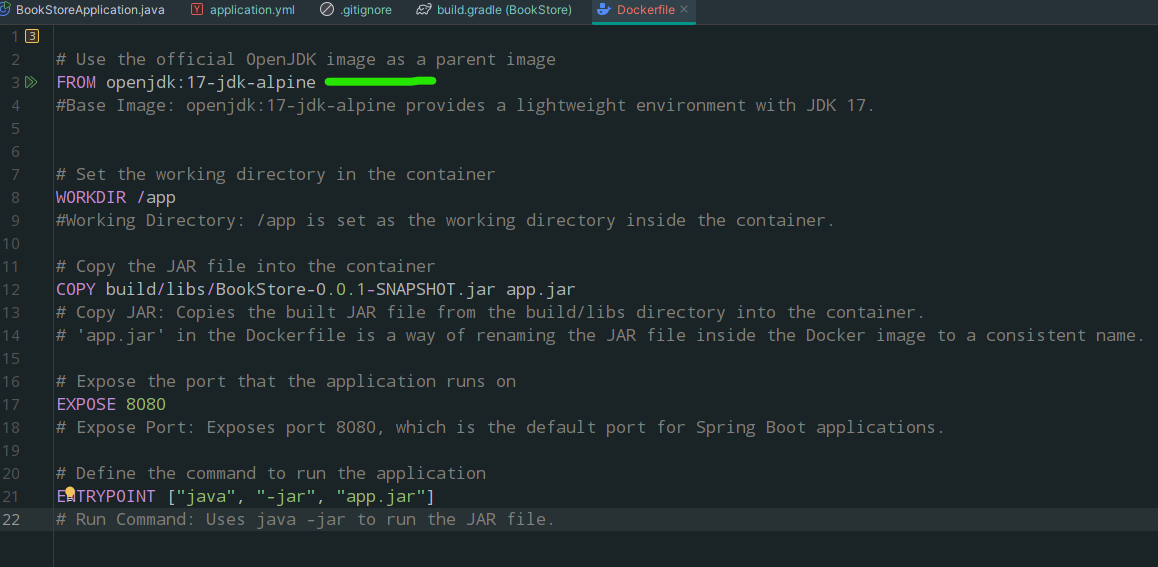
Error : Jar File configuration is wrong in Dockerfile
ERROR [3/3] COPY build/libs/bookstore-0.0.1-SNAPSHOT.jar app.jar
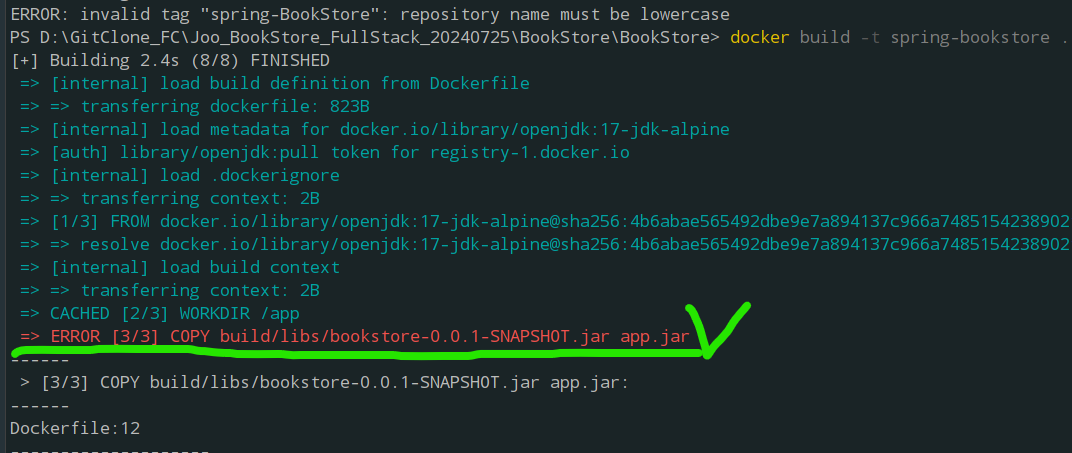
Resolve: Jar file name that alines with /build/libs built'Jar'
As you see, BookStore/build/libs/BookStore-0.0.1-SNAPSHOT.jar
But, Dockerfile -> COPY build/libs/bookstore-0.0.1-SNAPSHOT.jar app.jar
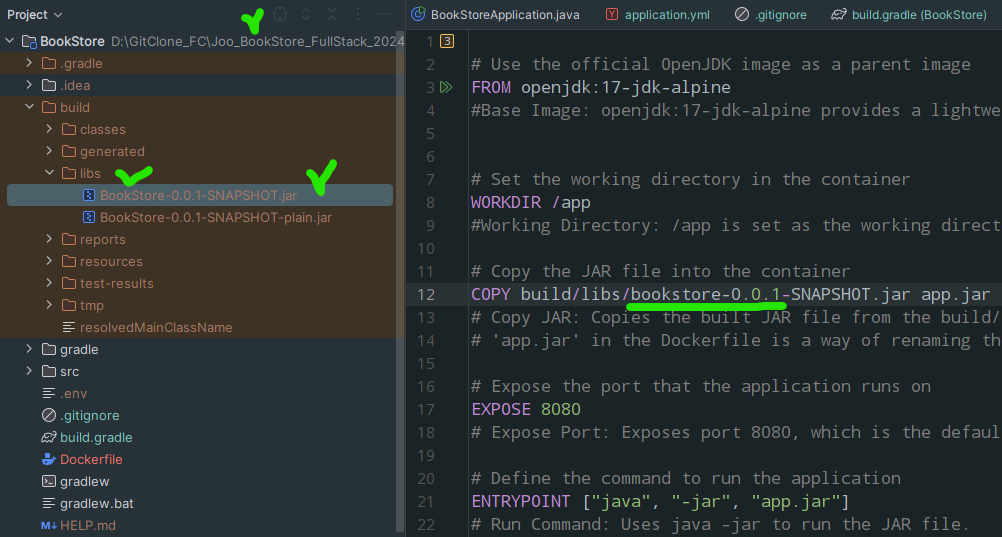
That should be like this :
COPY build/libs/BookStore-0.0.1-SNAPSHOT.jar app.jar

Error (Command, Directory name should be lowercase.)

Resolve : right command with lowercase
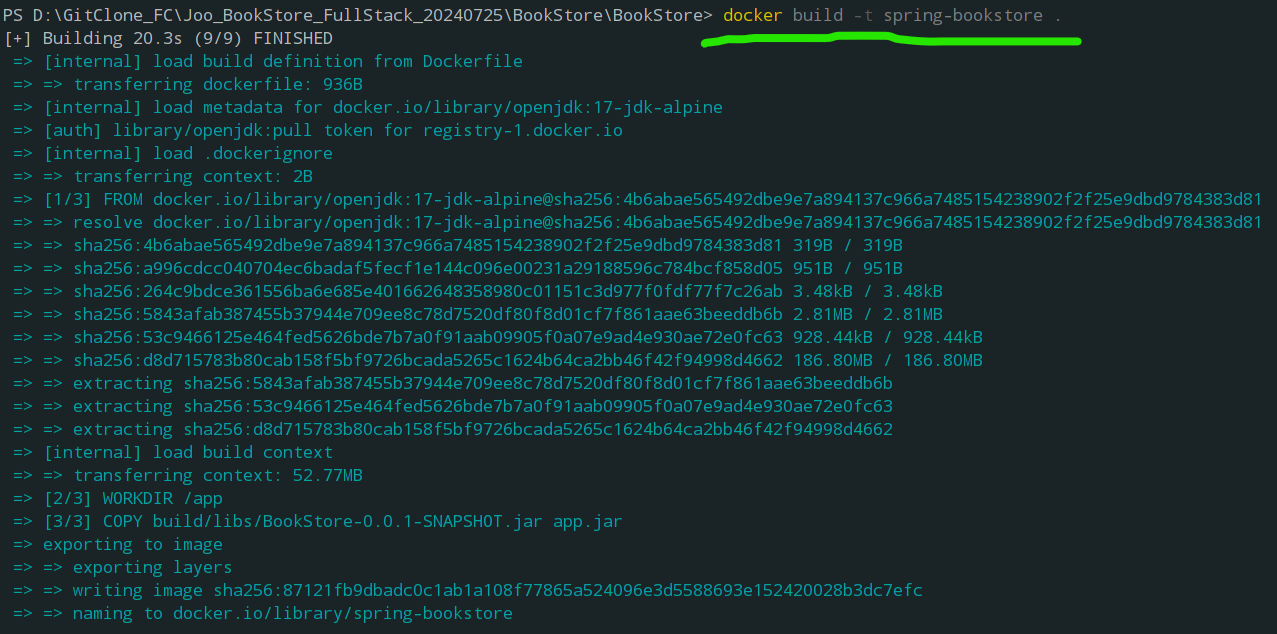
I can't see the spring-bookstore-container on Docker Desktop


and I have image, but.. I can't see the container.
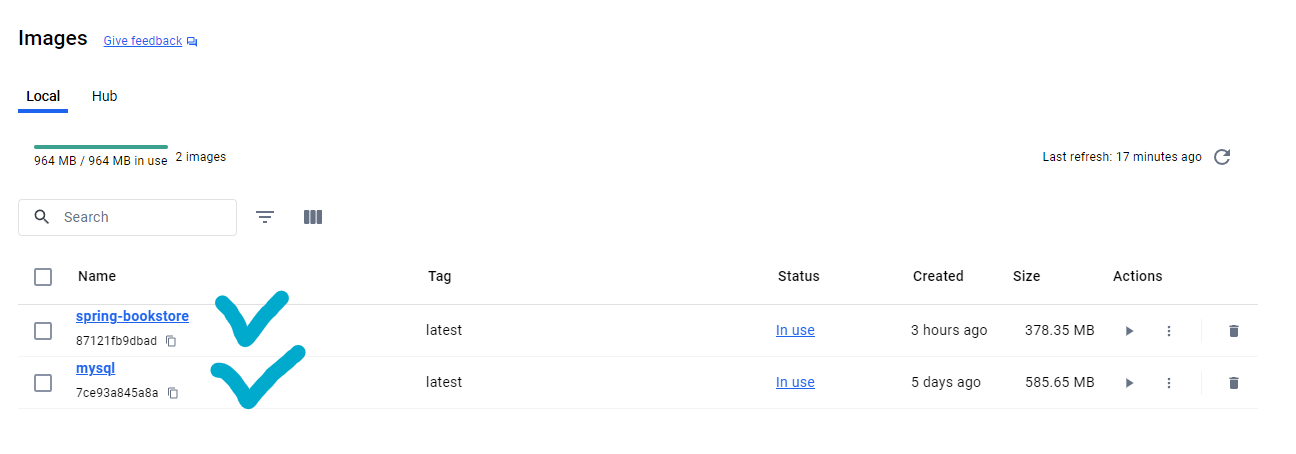
Even though I removed and recreated the container / restart docker, still there's no spring-bookstore-container.
Remove and Recreate the Container:
# Stop and remove the existing container
docker stop spring-bookstore-container
docker rm spring-bookstore-container
# Run a new container with port mapping and a name
docker run -d -p 8080:8080 --name spring-bookstore-container spring-bookstore
Still I can't see.
Later, if I know how to handle this, I will update.
Oh my,,, super idiot
I used filter.

Without filter, I can see both containers.
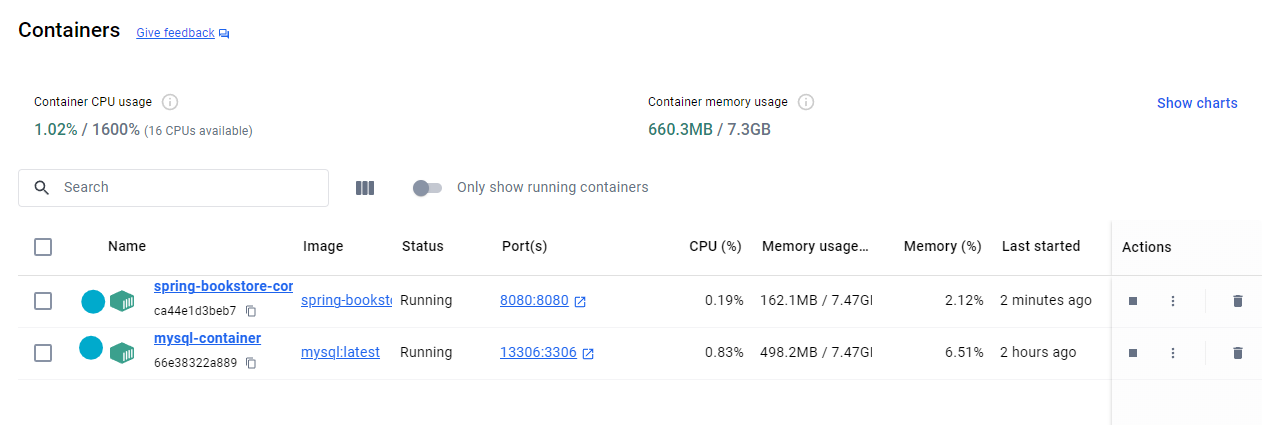
Subscribe to my newsletter
Read articles from Byung Joo Jeong directly inside your inbox. Subscribe to the newsletter, and don't miss out.
Written by
